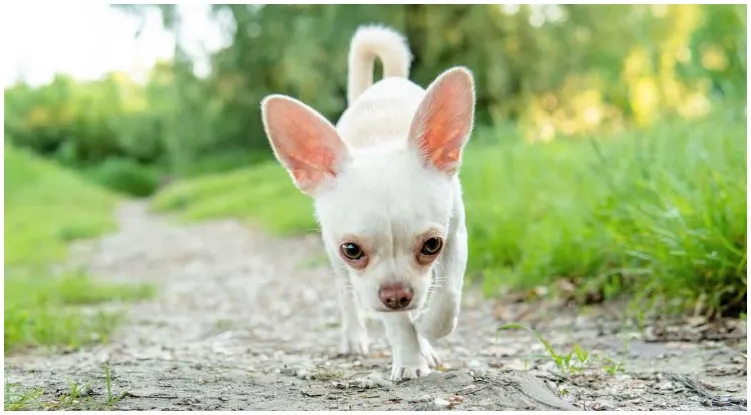While you’re here, read about other amazing crossbreeds:
- Pitbull Chihuahua Mix: The family dog
- Texas Heeler: Complete Breed Guide
- Agouti Husky: The Wolf Like Husky
- Lycan Shepherd: A mix of three breeds
- Corgi Husky Mix: The adorable and smart Horgi
- Doberman Pitbull Mix: Best Of Both Worlds?
- Peekapoo: The not so popular designer dog
- Bordoodle: Intelligent And Energetic
- Fawn French Bulldog: The classic beauty
Long-Haired White Chihuahua & White Apple-Head Chihuahua
First of all, we will talk about the white long-haired Chihuahua. It has no other markings and discolorations and its only distinctive trait is its long coat. To distinguish white from albino Chihuahuas are the dark features around the eyes and on the nose.
How to spot the white apple-head Chihuahua? The muzzle and forehead create a harsh angle of 90 degrees. When we compare to the long-haired Chihuahua, this Chi has a shorter coat, so they have short hair. Also, the legs are short. The eyes are expressive. The overall look – unique! Want to learn more things? Keep reading!
The Chi is a small dog, but did you know there is even a smaller variety, the teacup Chihuahua?
The fact is if you’re fond of all-white dogs, you must be able to determine the differences between a white puppy and an albino one. First off, albinism is a genetic condition, not only a coat color. The eyes, skin, and coat of albino dogs are completely without pigmentation.
But, logically white-coated dogs produce the color white, while albino dogs are white because of pigmentation absence. As simple as that!
How Do They Get Their White Coat?
It’s not easy to explain the concept of genetics, but we’ll try to put it as simple as possible. First, you should know that there are recessive and dominant genes. The full white coat of a Chi has been at the mercy of its gene pool.
As with everything, genes play an important role in determining a dog’s appearance. It controls the pigments produced (eumelanin and pheomelanin) and where they are produced. You should know that the two types of pigment make a wide range of dog coat colors, including white.
White Chihuahuas developed a white coat primarily because their parents don’t have black pigments in their genes – which does make sense. Since black is dominant and is absent from the parents’ genetic makeup, the offspring come out white as well. Already thinking of getting one? Why not – hurry up!
There are many other crossbreeds worth getting to know:
- Doberman Rottweiler Mix: Breed Info
- Corgi Beagle Mix: The always happy Beagi
- Colorado Bulldog: What You Have To Know
- Bully Pitbull Mix: The dog that is not for everyone
- Black Pitbull: Elegant And Fierce
- Newfypoo: The Adorable Hybrid
- Panda German Shepherd: Breed Guide
- Harlequin Great Dane: The breathtaking canine
- Saint Berdoodle: The gentle giant and family dog
Will A White Chihuahua Puppy Change Colors As It Grows?
The answer is yes! But, all Chihuahuas can have a coat color and skin color change. This is a process that happens gradually, and it appears to be perfectly normal. This is not happening just like that. There are many factors that contribute to the change, such as age, health issues, or environmental elements.
One fact is that many white Chihuahuas turn cream. But, this can be quite frustrating for a dog owner who was expecting to have a white Chihuahua in puppyhood and adulthood.
Also, another color change is the appearance of dark spots on the white coat. But, when this only happens is when the white color has been produced due to the spotting gene known as the S locus gene. Luckily for you and everyone, it’s quite uncommon for solid white Chis.
If you want to be 100% sure about owning a pure white adult Chihuahua, the best way to ensure this is to see the puppy’s parents first. It’s almost 100% correct that white Chis will produce all-white puppies. You should also see the parents make sure they are healthy. These dogs tend to have blood sugar problems, so it’s important to make sure the parents are healthy.
Do Kennel Clubs Accept Them?
Before we start, there are several factors that determine whether a dog can be recognized by an official kennel club or not. As we know, white Chihuahuas are rare, and breeding them is quite difficult. Thus, many people believe their acceptance to kennel clubs is questionable.
It’s true that the American Kennel Club (AKC) does recognize Chihuahuas. But, while they are recognized as a breed, some of their colors aren’t accepted by the club’s standards.
You don’t have to worry! White is, luckily, a part of the AKC color list; therefore white Chihuahuas are official and recognized.
Let’s see a list of factors that can disqualify a dog from being officially accepted:
1) if it has broken or cropped ears
2) if the dog weighs over 6 pounds
3) if a long haired Chi has a thin or almost bare coat.
4) if it has a bobtail or cropped tail
As we mentioned before, the white Chihuahua is rare and one of the hardest Chis to breed. You should know that it takes many generations to make a perfect white Chi. But, this dog should have claws and a nose in a lighter color. Black pigment on the skin should be non-existent.
The main and the biggest reason why breeding white Chihuahuas are so difficult is that you need two pure white Chihuahua parents to get a purebred white puppy.
Many people mistake cream Chis for white ones, so the end result isn’t a pure white puppy. As said earlier, always check their parents!
You can also check out some of our other interesting articles:

